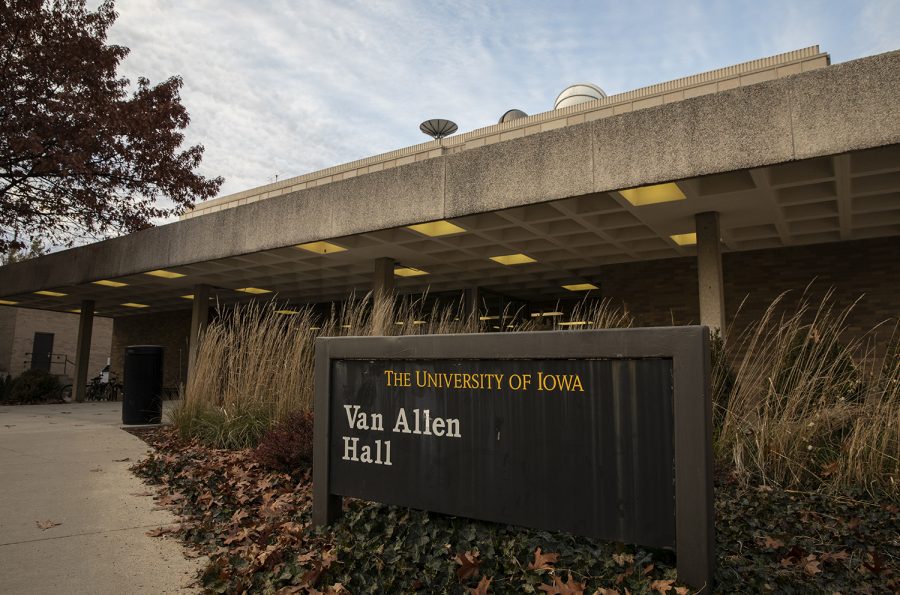The University of Iowa Physics and Astronomy Department recently announced a team of researchers, led by professors Gregory Howes and Daniel McGinnis, who will investigate how turbulence in the solar wind heats plasma.
According to Howes, solar wind is a stream of plasma, or charged particles, that flows out from the sun at high speeds — around 500 kilometers per second. The solar wind plasma then interacts with the Earth’s magnetic field creating the Earth’s magnetosphere, which helps protect the planet from the harmful radiation.
However, the solar wind is not a smooth, calm flow. Instead, it’s turbulent, with a lot of jumbling and mixing of the plasma. The turbulence in the solar wind needs to be dissipated, and the energy from this dissipation ends up heating the solar wind plasma, Howes said.
The research being conducted by Howes, McGinnis, and the rest of the team aims to understand the specific physical processes and mechanisms by which this turbulence in the solar wind is dissipated, leading to the heating of the protons and electrons in the solar wind plasma.
The research and team will be funded by a $733,873 grant that from NASA, and the team has already begun conducting and studying research.
According to NASA’s website, “NASA initiated the National Space Grant College and Fellowship Project, also known as Space Grant, in 1989. Space Grant is a national network of colleges and universities.”
NASA continues to fund education, research, and public engagement projects through a national network, which includes over 850 affiliates from universities, colleges, industry, museums, science centers, and state agencies.
By funding national research programs, NASA aims to encourage interdisciplinary education, research and public service programs related to aerospace and collaborative programs and recruit and train individuals, among several other things.
Research at the UI began in August, McGinnis said. The team has begun researching measurements of electric and magnetic fields and plasma particles from the Solar Orbiter spacecraft, which is a joint European Space Agency and NASA mission, and it is orbiting just inside the orbit of Mercury.
“It’s important for understanding what impact solar weather can have on Earth’s systems — like our satellites and our power grid,” McGinnis said. “If we have a big solar event that produces a big outburst of solar wind…we want to be able to predict when these big events will happen.”
McGinnis said the team will continue to develop models and discover why the solar wind continues to heat up in transit and what role turbulence plays in that, along with how it is being accelerated off the sun and pushed into space.
After examining the data from the Solar Orbiter spacecraft, McGinnis said he creates computer codes or programs to process the data. The team will then apply the field-particle correlation technique, which was created by Howes, and inspect data points among other things.
RELATED: DITV: University of Iowa Receives $1.5 Million From NASA
Howes, who has been at UI for 17 years, specializes in theoretical plasma physics, which he applies to space plasmas, the environment and space.
Howes echoed the importance of understanding how the solar wind plasma is affected by the sun to protect spacecraft, communication satellites and GPS navigation satellites.
“Our research is effectively very fundamental research, enabling us to make predictions about how the Earth’s near space environment evolves in response to different events affecting us from the sun,” Howes said. “That’s kind of the long-term goal of both my research group and many of the other space physics researchers.”
The research will also allow four graduate students to be a part of the team to conduct research on different aspects of the work.
“There is funding in this grant for graduate student work, and Dr. McGinnis will, along with me, be helping to mentor some of those graduate students,” said Howes.
McGinnis also said there are a variety of ways undergraduate and graduate students can be involved with research at the UI. Depending on what the student is interested in, there are different types of projects they can participate in, such as reading papers, field research, or lab studies.
The grant will allow Howes, McGinnis, and the rest of the team to develop and conduct research over the span of three years. Their research will also open more opportunities not only in the physics and astronomy department but around the entire campus.



